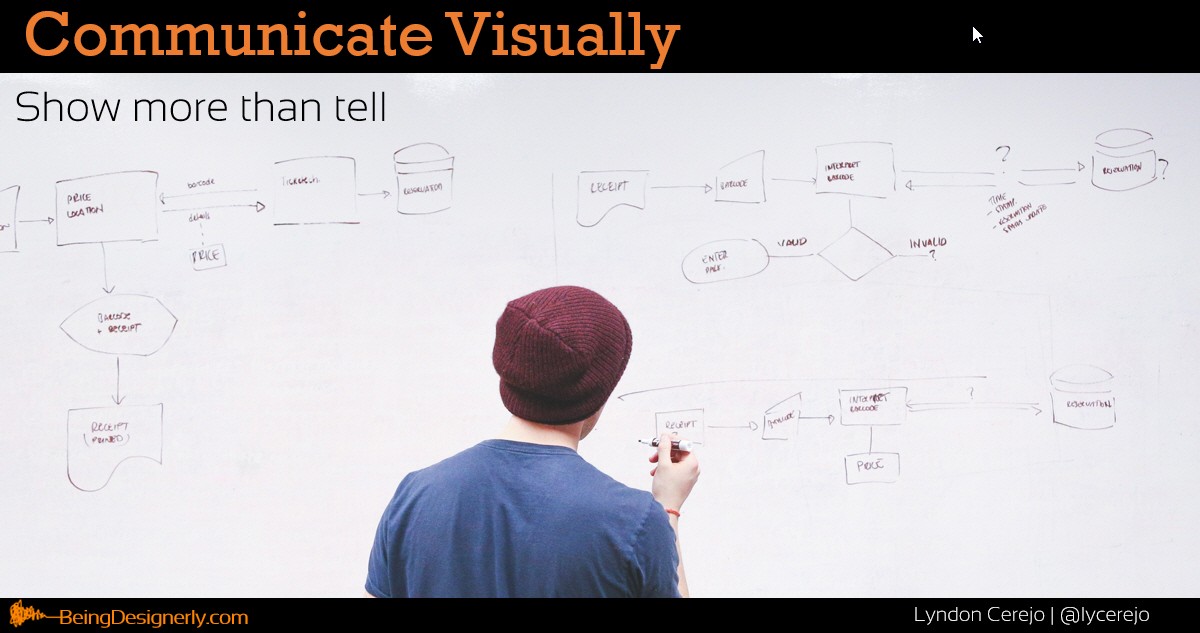
Being Designerly: Communicate Visually
In this series about Being Designerly, we explore ways to be more creative by thinking, feeling, and acting like a designer. In previous articles, we discussed designerly behaviors and skills such as Putting People First, Being Curious, Being Observant, Thinking Critically, Having Empathy, Advocating for Users and Working Transparently. We now focus on the skills of doing (hands) by Communicating Visually.
Communicate Visually: Show more than tell.
Communication is a complex topic that includes many ways people exchange information and ideas. We all communicate, but designers tend to communicate visually. But first, let's highlight a few important communication elements: listening, adapting, and storytelling.
Listening is a key part of communication. Communication has many parallels to user-centered design – you must know the recipient of the message, use those insights to design and deliver your communication, and then ensure that the message was received as intended. All involve listening.
Effective communication involves speaking in a way that resonates with the audience – for designers, that usually means speaking the language of non-design stakeholders. In his book, “Articulating Design Decisions,” Tom Greever emphasizes that designers should explain their designs in the context of goals that matter to executives and non-design professionals.
Storytelling is a form of communication that paints a vivid picture in people’s minds and makes the message memorable. I’m not talking about tossing in a story for the sake of it, but using stories or anecdotes to drive home insights, action, or provide context or perspective. For example, when presenting customer satisfaction data, humanize it with an actual quote or feedback from a customer that supports or even contradicts the data.
Listening, adapting the message and storytelling are ways to aspects that improve communication. However, when communicating with spoken or written words, people may all visualize the same thing differently. No matter how painstakingly a speaker or author describes a character or a situation, chances are high that two people sitting right next to each other both have different images in their minds. However, when there is an accompanying image or visual, people are literally on the same page (or slide, graph), which reduces the risk of them imagining different things. That’s the power of thinking and communicating visually.
Not all designers are artistic, but you don’t have to be artistic to be a visual thinker or communicator. Even a rough sketch on a whiteboard or a notepad can often communicate information faster than the written or verbal form. The aim is to make ideas tangible quickly, to get to the right idea faster. User researchers and designers commonly use visualizations to help them make sense of data and come up with new ideas.
Next time you describe something, instead of writing a page of instructions or talking it out, use a quick sketch. Describing a process? Boxes and arrows are powerful. Talking about a screen or two? A rough layout, highlighting the important parts, along with an arrow showing how you get from one to another, is more powerful. Or a quick screen recording. Sketching not your thing? Use images. I’ve used LEGO photography in articles and presentations. You can also mock-up something without advanced design tools. I once had a non-design leader who communicated visually using PowerPoint. And if you are in the mood to explore and experiment, try one of the many AI text-to-image generators.
Show more than tell.
The next article will focus on the designerly behavior of collaboration and co-creation. You should also sign up for curated content on the topic every other week at news.beingdesignerly.com. I hope these will help you, designer or not, be more creative and innovative by being designerly!